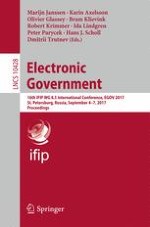2017 | Buch
Electronic Government
16th IFIP WG 8.5 International Conference, EGOV 2017, St. Petersburg, Russia, September 4-7, 2017, Proceedings
herausgegeben von: Marijn Janssen, Karin Axelsson, Olivier Glassey, Dr. Bram Klievink, Robert Krimmer, Ida Lindgren, Peter Parycek, Hans J. Scholl, Dmitrii Trutnev
Verlag: Springer International Publishing
Buchreihe : Lecture Notes in Computer Science
